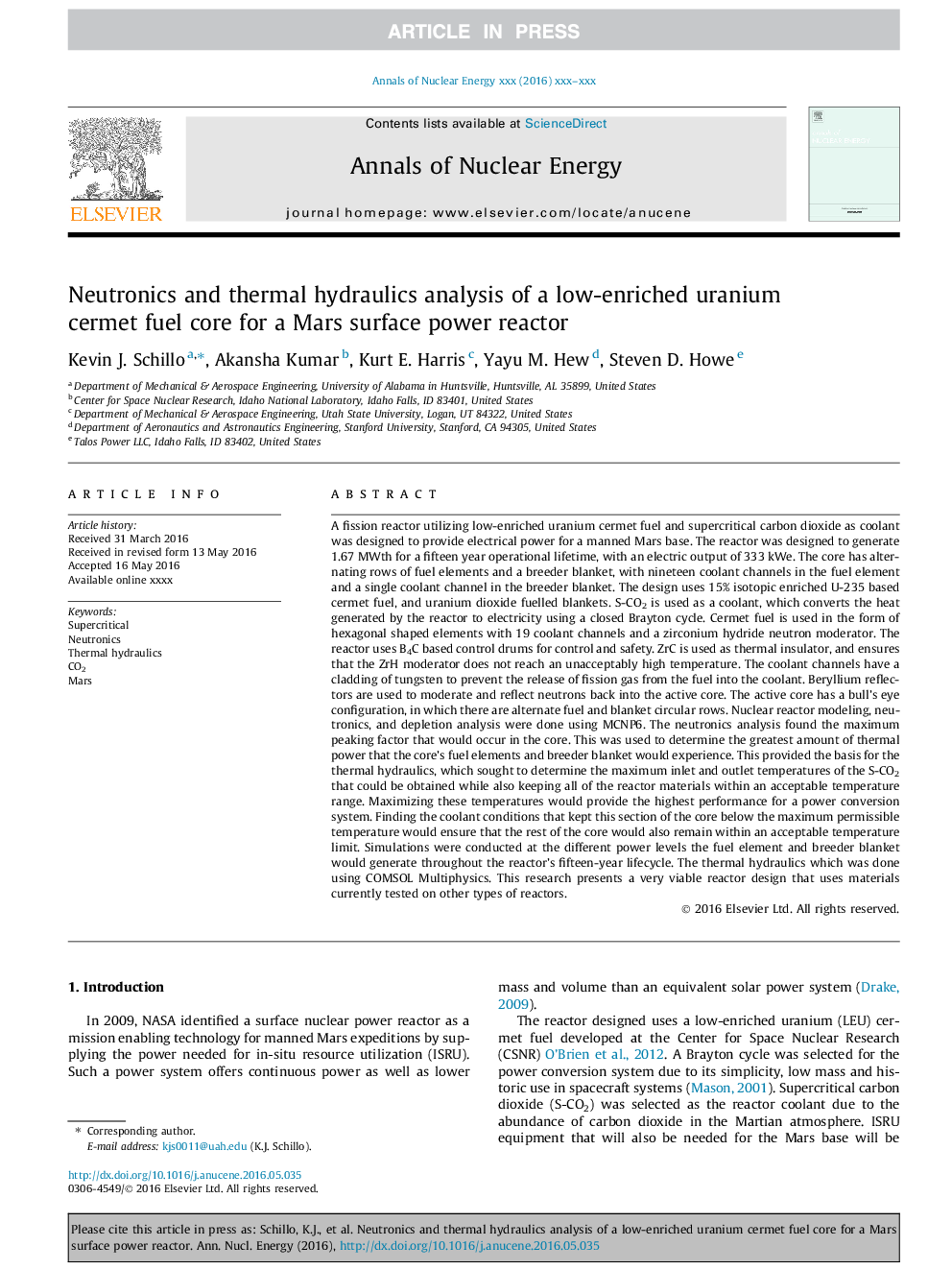| کد مقاله | کد نشریه | سال انتشار | مقاله انگلیسی | نسخه تمام متن |
|---|---|---|---|---|
| 8067545 | 1521101 | 2016 | 6 صفحه PDF | دانلود رایگان |
عنوان انگلیسی مقاله ISI
Neutronics and thermal hydraulics analysis of a low-enriched uranium cermet fuel core for a Mars surface power reactor
ترجمه فارسی عنوان
تجزیه و تحلیل هیدرولیک حرارتی نوری و حرارتی هسته سوخت هسته ای اورانیوم غنی شده برای یک رآکتور انرژی سطحی مریخ
دانلود مقاله + سفارش ترجمه
دانلود مقاله ISI انگلیسی
رایگان برای ایرانیان
کلمات کلیدی
موضوعات مرتبط
مهندسی و علوم پایه
مهندسی انرژی
مهندسی انرژی و فناوری های برق
چکیده انگلیسی
A fission reactor utilizing low-enriched uranium cermet fuel and supercritical carbon dioxide as coolant was designed to provide electrical power for a manned Mars base. The reactor was designed to generate 1.67Â MWth for a fifteen year operational lifetime, with an electric output of 333Â kWe. The core has alternating rows of fuel elements and a breeder blanket, with nineteen coolant channels in the fuel element and a single coolant channel in the breeder blanket. The design uses 15% isotopic enriched U-235 based cermet fuel, and uranium dioxide fuelled blankets. S-CO2 is used as a coolant, which converts the heat generated by the reactor to electricity using a closed Brayton cycle. Cermet fuel is used in the form of hexagonal shaped elements with 19 coolant channels and a zirconium hydride neutron moderator. The reactor uses B4C based control drums for control and safety. ZrC is used as thermal insulator, and ensures that the ZrH moderator does not reach an unacceptably high temperature. The coolant channels have a cladding of tungsten to prevent the release of fission gas from the fuel into the coolant. Beryllium reflectors are used to moderate and reflect neutrons back into the active core. The active core has a bull's eye configuration, in which there are alternate fuel and blanket circular rows. Nuclear reactor modeling, neutronics, and depletion analysis were done using MCNP6. The neutronics analysis found the maximum peaking factor that would occur in the core. This was used to determine the greatest amount of thermal power that the core's fuel elements and breeder blanket would experience. This provided the basis for the thermal hydraulics, which sought to determine the maximum inlet and outlet temperatures of the S-CO2 that could be obtained while also keeping all of the reactor materials within an acceptable temperature range. Maximizing these temperatures would provide the highest performance for a power conversion system. Finding the coolant conditions that kept this section of the core below the maximum permissible temperature would ensure that the rest of the core would also remain within an acceptable temperature limit. Simulations were conducted at the different power levels the fuel element and breeder blanket would generate throughout the reactor's fifteen-year lifecycle. The thermal hydraulics which was done using COMSOL Multiphysics. This research presents a very viable reactor design that uses materials currently tested on other types of reactors.
ناشر
Database: Elsevier - ScienceDirect (ساینس دایرکت)
Journal: Annals of Nuclear Energy - Volume 96, October 2016, Pages 307-312
Journal: Annals of Nuclear Energy - Volume 96, October 2016, Pages 307-312
نویسندگان
Kevin J. Schillo, Akansha Kumar, Kurt E. Harris, Yayu M. Hew, Steven D. Howe,
